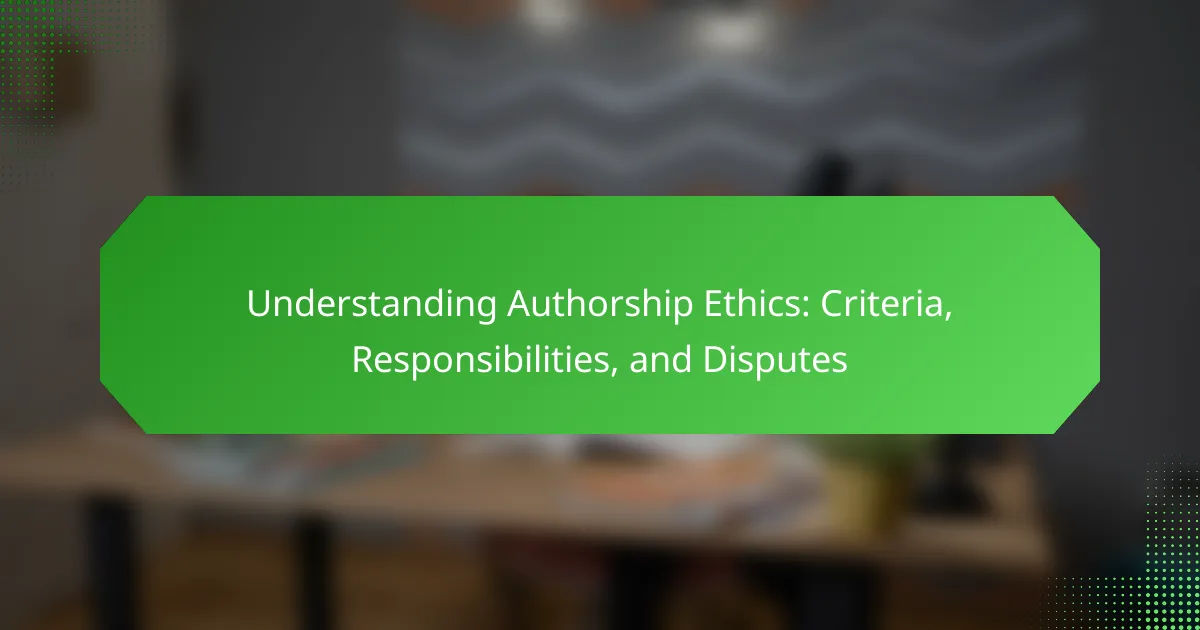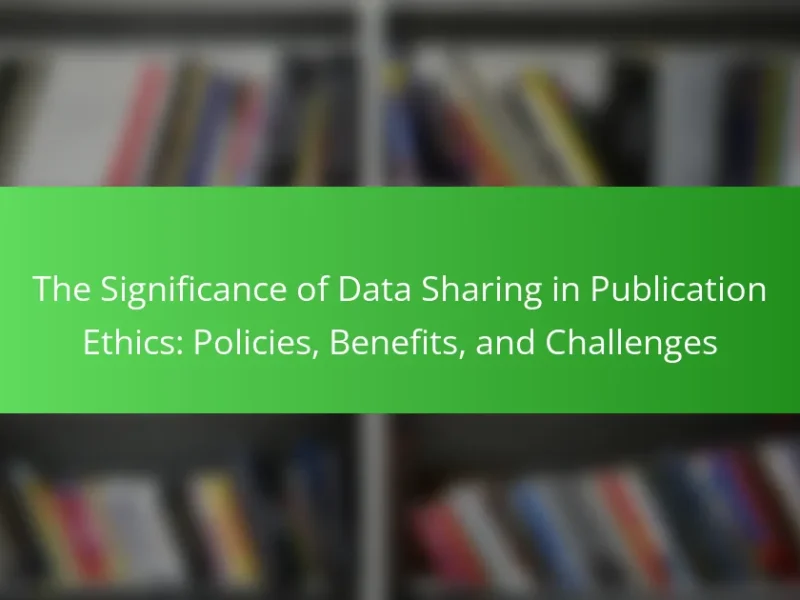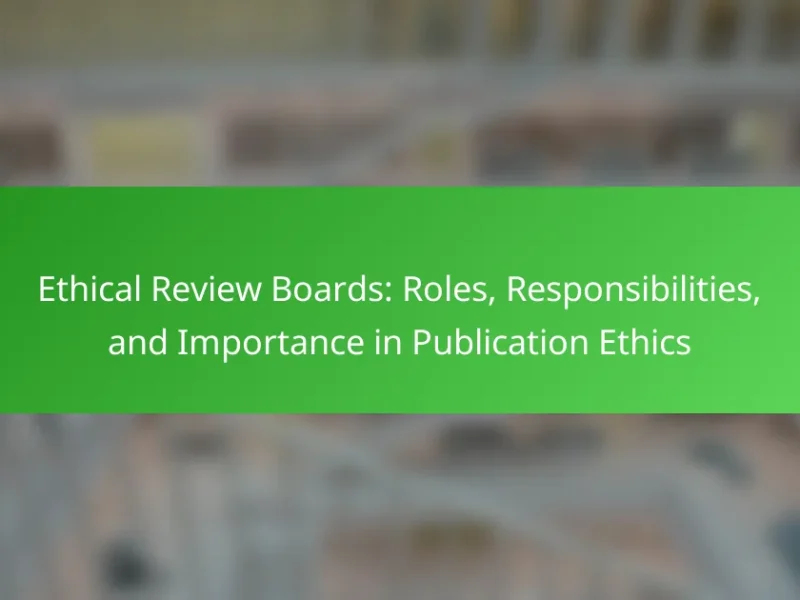Authorship ethics encompass fundamental principles such as transparency, accountability, and credit attribution, which are essential for maintaining integrity in scholarly communication. Transparency involves disclosing all contributions to a work, while accountability requires authors to take responsibility for the accuracy and integrity of their content. Credit attribution ensures all contributors receive appropriate recognition, fostering trust within the academic community. Key responsibilities for authors include ensuring originality to prevent plagiarism, maintaining accuracy through fact-checking, and considering their audience in writing style. Common disputes in authorship ethics, such as credit allocation and ghost authorship, highlight the importance of ethical practices in preserving the credibility of published research.

What are the fundamental principles of authorship ethics?
The fundamental principles of authorship ethics include transparency, accountability, and credit attribution. Transparency ensures that all contributions to a work are disclosed. This prevents misrepresentation of authorship and acknowledges the role of each contributor. Accountability involves taking responsibility for the content and its integrity. Authors must ensure the accuracy of their work and address any ethical issues that arise. Credit attribution requires giving appropriate recognition to all contributors. This principle is vital in maintaining trust and respect within the academic community. These principles are supported by guidelines from organizations such as the Committee on Publication Ethics (COPE). COPE emphasizes the importance of ethical authorship practices to uphold the quality and integrity of scholarly communication.
How do these principles apply to different fields of study?
Authorship ethics principles apply variably across different fields of study. In the sciences, these principles emphasize transparency in data sharing and proper attribution of contributions. For instance, in biomedical research, guidelines from the International Committee of Medical Journal Editors mandate clear authorship criteria to ensure accountability.
In the humanities, authorship ethics focus more on intellectual contributions and the acknowledgment of collaborative influences. This is evident in literary studies, where the significance of citation practices is highlighted to respect original ideas.
In social sciences, authorship ethics involve considerations of representation and the impact of research on communities. The American Psychological Association stresses the importance of ethical standards in authorship to protect vulnerable populations.
Each field has specific guidelines that reflect its unique values and practices regarding authorship, ensuring integrity and respect for intellectual property.
What are the specific ethical considerations in academic authorship?
The specific ethical considerations in academic authorship include proper attribution, accountability, and transparency. Proper attribution ensures that all contributors receive credit for their work. Accountability involves taking responsibility for the content and findings presented in the publication. Transparency requires disclosing any conflicts of interest that may influence the research. Additionally, ethical authorship necessitates adherence to the guidelines set by academic institutions and publishers. These guidelines often include criteria for authorship based on contributions to the research and writing process. Violating these ethical standards can lead to issues such as plagiarism or authorship disputes. The Committee on Publication Ethics (COPE) provides resources to help navigate these ethical considerations.
How do ethical standards differ in creative and professional writing?
Ethical standards in creative writing focus on artistic expression and originality. Creative writers prioritize personal voice and storytelling. They often explore subjective truths and emotional resonance. This can lead to flexible interpretations of truth and representation.
In contrast, professional writing emphasizes accuracy and factual integrity. Professional writers must adhere to specific guidelines and standards. They prioritize clarity, objectivity, and the audience’s needs. This often involves strict adherence to factual information and ethical sourcing.
The difference lies in the intent and audience. Creative writing seeks to evoke emotions and provoke thought. Professional writing aims to inform, persuade, or instruct while maintaining credibility. These divergent goals shape their respective ethical frameworks.
Why is authorship attribution important?
Authorship attribution is important because it establishes credit for intellectual contributions. Accurate attribution recognizes the efforts of authors and enhances their professional reputation. It also ensures accountability for the content produced. Furthermore, proper attribution helps prevent plagiarism and promotes ethical standards in research and publication. Studies show that clear authorship guidelines improve transparency in academic writing. This transparency fosters trust among readers and the academic community. Ultimately, authorship attribution is vital for maintaining integrity in scholarly communication.
How does proper attribution affect academic integrity?
Proper attribution is essential for maintaining academic integrity. It acknowledges the original authors’ contributions and ideas. This practice prevents plagiarism, which undermines trust in academic work. When students and researchers properly attribute sources, they uphold ethical standards in scholarship. According to the American Psychological Association, proper citation fosters transparency and accountability. This adherence to attribution guidelines supports the credibility of academic research. Studies show that institutions emphasizing attribution have lower rates of academic misconduct. Thus, proper attribution is a cornerstone of academic integrity.
What role does authorship play in the credibility of research?
Authorship significantly influences the credibility of research. It establishes accountability for the content presented. Clear authorship indicates who conducted the research and contributed to the findings. This transparency helps readers assess the qualifications and expertise of the authors. Credible authors typically have relevant academic or professional backgrounds. Their affiliations with reputable institutions also enhance trust in the research. Furthermore, proper authorship practices can reduce instances of plagiarism and unethical conduct. Research shows that studies with well-credited authors are more likely to be cited and trusted within the academic community.

What responsibilities do authors have in the writing process?
Authors have several key responsibilities in the writing process. They must ensure originality in their work to avoid plagiarism. This involves properly citing sources and giving credit to other authors’ ideas. Authors are also responsible for maintaining accuracy in their content. This includes fact-checking and verifying information before publication.
Furthermore, authors should consider their audience when writing. They need to use appropriate language and style to engage readers effectively. Ethical considerations are also crucial. Authors must be transparent about conflicts of interest and disclose any potential biases.
Lastly, authors have a duty to revise and edit their work thoroughly. This ensures clarity and coherence in their writing. Each of these responsibilities contributes to the integrity and quality of the writing process.
How can authors ensure transparency in their work?
Authors can ensure transparency in their work by clearly disclosing their research methods and sources. They should provide detailed information about their data collection processes. This includes specifying sample sizes and methodologies used. Authors must also acknowledge any potential conflicts of interest. Citing all sources accurately is essential to uphold credibility. Furthermore, authors should allow access to supplementary materials when applicable. This practice enables peer verification of findings. Transparency fosters trust and accountability in scholarly communication.
What are the best practices for declaring conflicts of interest?
The best practices for declaring conflicts of interest include transparency, timely disclosure, and clear documentation. Individuals should disclose any potential conflicts at the earliest opportunity. This includes financial interests, personal relationships, or affiliations that may influence judgment. Documentation should be thorough and accessible, detailing the nature of the conflict. Regular updates are necessary if circumstances change. Adhering to institutional policies on conflict of interest is crucial. Training on recognizing and managing conflicts can enhance compliance. These practices help maintain integrity and trust in research and professional relationships.
How should authors handle contributions from collaborators?
Authors should clearly define the roles and contributions of collaborators from the outset. This includes specifying each collaborator’s responsibilities in the project. Regular communication is essential to ensure that all parties are on the same page. Authors must also document contributions to provide transparency. Establishing authorship criteria at the beginning helps avoid disputes later. Acknowledging contributions appropriately is crucial for ethical practices. This approach aligns with guidelines from the International Committee of Medical Journal Editors. Such guidelines emphasize transparency and proper attribution in collaborative works.
What ethical dilemmas might authors face?
Authors may face several ethical dilemmas, including plagiarism, copyright infringement, and misrepresentation. Plagiarism involves using another’s work without proper attribution. This can damage an author’s credibility and lead to legal consequences. Copyright infringement occurs when authors use protected material without permission. This can result in lawsuits and financial penalties. Misrepresentation happens when authors present false information or data. This undermines trust and can harm readers or the broader community. Additionally, conflicts of interest can arise if authors have personal or financial stakes in their work. These dilemmas highlight the importance of ethical standards in authorship.
How can authors navigate issues of plagiarism?
Authors can navigate issues of plagiarism by understanding and adhering to proper citation practices. They should accurately attribute ideas, quotes, and data to their original sources. Utilizing plagiarism detection tools can help identify unintentional similarities with existing works. Familiarity with copyright laws is essential for authors to understand fair use. Authors should also keep thorough notes on their research sources to avoid accidental plagiarism. Engaging in peer review can provide additional oversight and feedback on originality. Continuous education on authorship ethics further equips authors to maintain integrity in their writing.
What should authors do when faced with disputes over authorship?
Authors should first communicate openly with all parties involved in the dispute. Open dialogue can help clarify misunderstandings. Next, they should review any relevant agreements or guidelines regarding authorship. This includes checking institutional or publisher policies. If the dispute persists, authors may consider mediation by a neutral third party. Mediation can facilitate a resolution without escalating the conflict. Lastly, if necessary, authors should document all communications and decisions made during the process. Documentation serves as a record should further action be required.

What common disputes arise in authorship ethics?
Common disputes in authorship ethics include issues of credit allocation, ghost authorship, and contributions misrepresentation. Credit allocation disputes arise when contributors disagree on the order of authorship or the amount of credit each should receive. Ghost authorship occurs when individuals contribute significantly but are not listed as authors, leading to ethical concerns about transparency. Misrepresentation of contributions happens when authors claim credit for work they did not perform or downplay the contributions of others. These disputes can undermine trust in academic and professional work, affecting the integrity of published research.
How can authorship disputes be resolved?
Authorship disputes can be resolved through clear communication and negotiation among the parties involved. Establishing a dialogue helps clarify each author’s contributions and intentions. Mediation by a neutral third party can also facilitate resolution. Documenting contributions and agreements in writing can prevent future disputes. In academic settings, adhering to established guidelines from organizations like the International Committee of Medical Journal Editors can provide a framework for resolution. Ultimately, fostering a culture of transparency and collaboration in research can minimize the occurrence of disputes.
What are the steps to take when a dispute occurs?
Identify the nature of the dispute. Gather all relevant information and documents. Communicate with all parties involved to clarify positions. Attempt to resolve the issue informally through discussion. If unresolved, escalate to a formal process such as mediation. Document all steps taken during the resolution process. Follow institutional or organizational policies regarding disputes. Seek legal advice if necessary to understand rights and obligations.
How can institutions support authors in resolving conflicts?
Institutions can support authors in resolving conflicts by providing clear guidelines and mediation services. They should establish formal policies that outline conflict resolution processes. Training programs can equip authors with skills to address disputes effectively. Institutions can also create dedicated committees to handle authorship disputes impartially. Access to legal advice can help authors navigate complex issues. Regular workshops on authorship ethics can foster a culture of open communication. Supportive environments encourage authors to voice concerns without fear of repercussions. These measures collectively enhance conflict resolution among authors.
What resources are available for understanding authorship ethics?
Resources for understanding authorship ethics include academic journals, guidelines from professional organizations, and books on research integrity. The Committee on Publication Ethics (COPE) provides comprehensive guidelines on authorship ethics. The International Committee of Medical Journal Editors (ICMJE) also offers criteria for authorship. Books like “Research Misconduct: A Handbook of Practical Solutions” by John D. Lee provide in-depth discussions on ethical authorship. Additionally, online courses and webinars on research ethics are available through platforms like Coursera and edX. These resources collectively help clarify responsibilities and criteria related to authorship.
Which organizations provide guidelines on authorship ethics?
The International Committee of Medical Journal Editors (ICMJE) provides guidelines on authorship ethics. They outline criteria for authorship in biomedical research. The Committee on Publication Ethics (COPE) also offers resources on ethical authorship practices. The American Psychological Association (APA) provides specific guidelines for authorship in psychology and related fields. Additionally, the World Association of Medical Editors (WAME) addresses authorship ethics in medical publishing. These organizations collectively contribute to establishing ethical standards for authorship across various disciplines.
How can authors stay informed about evolving ethical standards?
Authors can stay informed about evolving ethical standards by regularly engaging with professional organizations. These organizations often publish guidelines and updates on ethical practices. Attending workshops and conferences also provides valuable insights into current ethical discussions. Subscribing to relevant journals and newsletters keeps authors updated on recent developments. Networking with peers allows for sharing experiences and best practices related to ethics. Additionally, following thought leaders in the field on social media can offer timely information and perspectives. Lastly, reviewing case studies of ethical dilemmas in authorship can provide practical examples of how to navigate ethical challenges.
What are best practices for maintaining ethical authorship?
Best practices for maintaining ethical authorship include proper attribution, transparency, and accountability. Authors should always credit the contributions of others accurately. This includes acknowledging co-authors and citing sources appropriately. Transparency in the research process is crucial. Authors must disclose any potential conflicts of interest. Accountability involves taking responsibility for the content published. This includes correcting errors promptly and addressing ethical concerns. Following guidelines from reputable organizations, such as the Committee on Publication Ethics, can help ensure ethical standards are met. Adhering to these practices fosters trust and integrity in academic and professional writing.
How can authors establish clear communication with co-authors?
Authors can establish clear communication with co-authors by setting regular meetings and using collaborative tools. Regular meetings can help ensure all voices are heard. Collaborative tools, such as shared documents and project management software, can streamline communication. Authors should also create a shared document outlining roles and responsibilities. This document can clarify expectations and reduce misunderstandings. Open and honest dialogue is essential for addressing concerns. Authors should encourage feedback and be receptive to suggestions. Additionally, establishing a communication protocol can help manage responses and timelines. This approach fosters a transparent and effective collaboration.
What strategies can authors implement to avoid ethical pitfalls?
Authors can implement several strategies to avoid ethical pitfalls. First, they should ensure proper citation of sources to prevent plagiarism. Accurate attribution of ideas and quotes is essential in maintaining integrity. Second, authors must disclose any conflicts of interest. Transparency about funding or personal connections enhances credibility. Third, they should adhere to guidelines set by relevant institutions or publishers. Following established ethical standards helps maintain professional conduct. Fourth, authors should seek peer review before publication. Constructive feedback can identify potential ethical issues. Lastly, continuous education on ethical practices is vital. Staying informed about evolving standards supports responsible authorship.
The main entity of the article is authorship ethics, which encompasses the principles, responsibilities, and disputes associated with academic and professional writing. Key principles include transparency, accountability, and credit attribution, which are vital for maintaining integrity in scholarly communication. The article explores how these principles apply across various fields of study, outlines specific ethical considerations, and discusses the importance of proper attribution in upholding academic integrity. Additionally, it addresses common authorship disputes and offers strategies for resolving conflicts, ensuring ethical standards are met in collaborative efforts.


